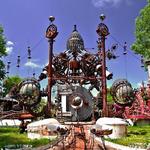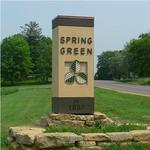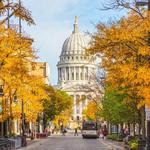Carlos & John
Things To Do
Bonham Theatre & Video
Locally-owned, family-run movie theater showing new releases with a video store with a large selection of current and classic movies. Enjoy real butter on your popcorn.
Merrimac Ferry
Take a free ride on the Colsac III! The ferry runs 24 hours a day between April and November, and connects WI-113 between Merrimac on the west and Okee on the east. The trip takes approximately 7 minutes and offers spectacular views of the river and the surrounding hills.
Carr Valley Cheese Store
"Eat cheese or die" may have been rejected for the state's license plates, but if there's one thing that says "Wisconsin," it's cheese. With a family history dating back to 1883, master cheesemaker Sid Cook oversees Carr Valley Cheese, which has has won numerous awards over the years and continues to offer delicious and unique Wisconsin cheeses and butters made from cow, goat, and sheep's milk.

Dr. Evermor's Forevertron and Art Park
Built in the 1980s, this is is the largest scrap metal sculpture in the world, standing 50 ft. high and 120 ft. wide, and weighing 300 tons. It is housed in Dr. Evermor's Art Park on Highway 12. Steampunk before the word even existed, the sculpture incorporates two Edison dynamos from the 1880s, lightning rods, high-voltage components from 1920s power plants, scrap from the nearby Badger Army Ammunition Plant, and the decontamination chamber from the Apollo 11 spacecraft. Its fictional creator, Dr. Evermor (born Tom Every in Brooklyn, Wisconsin), was a former demolition expert who spent decades collecting antique machinery for the sculpture and the surrounding fiction that justifies it. Dr. Evermor is a Victorian inventor who designed the Forevertron to launch himself, "into the heavens on a magnetic lightning force beam." Hours vary. Call for availability.
Ski-Hi Fruit Farm
In continuous production since 1907, Ski-Hi has 50 acres in apples with approximately 8,000 trees. The on-premises shop offers apples, freshly made baked goods, cider, and many other locally produced items. With stunning views and fresh fall air, Ski Hi is the kind of place made for taking some time to relax and enjoy the day.
Baraboo
The county seat of Sauk County and home of the Ringling Brothers! From 1884 to 1917 it was the headquarters of their circus and several others, leading to the nickname "Circus City." Today the Circus World Museum is located at the circus's former winter quarters. A living history museum, it has a collection of circus wagons and other circus artifacts. Downtown Baraboo, centered on the square of the neoclassical 1906 Sauk County Courthouse, is still vibrant with plenty of shops and restaurants to enjoy. The 1915 Beaux-Arts Al. Ringling Theatre is one of the oldest movie palaces in the country, and one of the few still in use.
Devil's Lake State Park
The largest state park in Wisconsin (and the third oldest) offers magnificent views from 500-foot quartzite bluffs overlooking 360-acre Devil's Lake, which was created by a glacier during the last ice age approximately 12,000 years ago. The sand at the bottom of Devil's Lake is thought to have been deposited by glaciers, as the spring-fed lake has no visible inlet. Devil's Lake is situated in the Baraboo Hills, which are much older than Devil's Lake itself, approximately 1.6 billion years old, once part of the Baraboo Range which is thought to have been taller than the Rocky Mountains.

Spring Green
Spring Green, on the banks of the Wisconsin River, has a reputation that far outranks its size, thanks to its most famous native son, architect Frank Lloyd Wright. Wright built his Wisconsin home, Taliesin, just outside Spring Green in the early 1900s. He also established a still-functioning school for architects here. Wright’s reputation may have helped Spring Green attract its large artisan community. This includes a nationally recognized classical theater company, the American Players Theatre. Just south of town, a more idiosyncratic architectural creation than anything Wright designed is on display at House on the Rock. Built atop a 60-foot chimney of rock, this former artist’s retreat has grown into a huge complex of several buildings housing a fantastical museum of oddities and collectibles.
Taliesin
Taliesin is the home, studio, school, and 800-acre country estate of Frank Lloyd Wright (1867-1959). Located in the rugged Driftless Region of southwestern Wisconsin near Spring Green, Taliesin is the name of Wright’s home as well as the estate that includes buildings from nearly every decade of Wright’s career from the 1890s to the 1950s. The Taliesin residence is the heart of a series of buildings that Wright designed for himself and his family members across the estate: Romeo & Juliet Windmill (1896), Hillside Home School (1903), Tan-y-Deri (1907), Hillside Drafting Studio (1932), Midway Barn (1949), Hillside Theater (1952), and the Frank Lloyd Wright Visitor Center (1967).
Babcock Hall Dairy Store
Since it opened in 1951, Babcock Hall is most famous for its ice cream, but the plant also produces award-winning cheeses and bottles locally-produced milk, all on-site in the Babcock Hall Dairy Plant. The Dairy Store includes a fountain with roughly 15 Babcock Ice Cream flavors--regular, and monthly features--which are available for sundaes, shakes and ice cream cones. The Dairy Store also offers breakfast and a lunch menu, including sandwiches, salads and soups. Metered parking is available west of the building and there also is 15 minute parking available on Linden Drive. An observation deck is available to view ice cream, cheese and milk production in the Dairy Plant. This is a self-guided tour, with a video presentation available. Best viewing time is weekday mornings.
Chazen Museum of Art
Offering free admission, the Chazen is home to the second-largest collection of art in Wisconsin: more than 20,000 works include paintings, sculpture, drawings, prints, photographs, and decorative arts. The permanent collection covers diverse historical periods, cultures, and geographic locations, from ancient Greece, Western Europe, and the Soviet Empire, to Moghul India, eighteenth-century Japan, and modern Africa. The museum's collection of American artists includes Mark Rothko, Andy Warhol, Grandma Moses, and many of Alexander Calder's works in several forms. Contemporary works by Shusaku Arakawa, a collection of regionalist paintings by John Steuart Curry, Russian Social Realist paintings by Georgy Ionin and Klavdy Vasiliyevich Lebedev, glass art by René Lalique, and a representation of Japanese woodblock prints are also exhibited.
Madison Museum of Contemporary Art
Housed in a soaring, Cesar Pelli designed building on State Street, the Madison Museum of Contemporary Art provides free exhibitions and education programs that engage people in modern and contemporary art. The four galleries offer changing exhibitions that feature established and emerging artists. The Rooftop Sculpture Garden provides an urban oasis with an incredible view. The permanent collection, which now numbers over 5,000 objects, is key to the museum's mission to preserve and interpret visual art for the education and enjoyment of the public. The collection includes works by some of the most significant American artists of the twentieth and twenty-first centuries. A portion of works in the collection reflect significant exhibitions presented by the museum; Wisconsin-based artists are also well represented.
Wisconsin State Capitol
The Beaux-Arts Capitol, built between 1906-17, is the tallest building in Madison, a distinction that has been preserved by legislation that prohibits buildings taller than the columns surrounding the dome. The capitol was constructed of 43 types of stone from six countries and eight states. The exterior stone is Bethel white granite from Vermont, making the exterior dome the largest granite dome in the world. The corridor floors, walls and columns are of marble from the states of Tennessee, Missouri, Vermont, Georgia, New York, and Maryland; granite from the states of Wisconsin and Minnesota; and limestone from the states of Minnesota and Illinois. The "Wisconsin" statue on the dome was sculpted during 1920 by Daniel Chester French. Its left hand holds a globe surmounted by an eagle and her right arm is outstretched to symbolize the state motto, "Forward". It wears a helmet with the state animal, the badger, on top.
Olbrich Botanical Gardens
Stroll 16 acres of outdoor gardens, from a Midwest-hardy Rose Garden to the only Thai Pavilion in the continental U.S. The Bolz Conservatory, an indoor tropical paradise, features exotic plants, flowers, birds, and fish. Open daily year-round, outdoor gardens are free to the public.

State Street
The famed State Street pedestrian mall links the Wisconsin State Capitol Square and King Street area to the University of Wisconsin campus. This unique shopping, dining and entertainment district features more than 370 shops, galleries, restaurants, and night spots, many locally-owned. It's also home to several museums and cultural destinations, such as the Wisconsin Historical Museum, Madison Museum of Contemporary Art and the Wisconsin Veterans Museum.
National Mustard Museum
More than 5,992 mustards from all 50 states and more than 70 countries, the collection of Mustard History is a sight to behold. From the exquisite Gibbons Collection of mustard pots to antique tins & jars and vintage advertisements, the National Mustard Museum is truly a shining temple to the “King of Condiments”.
